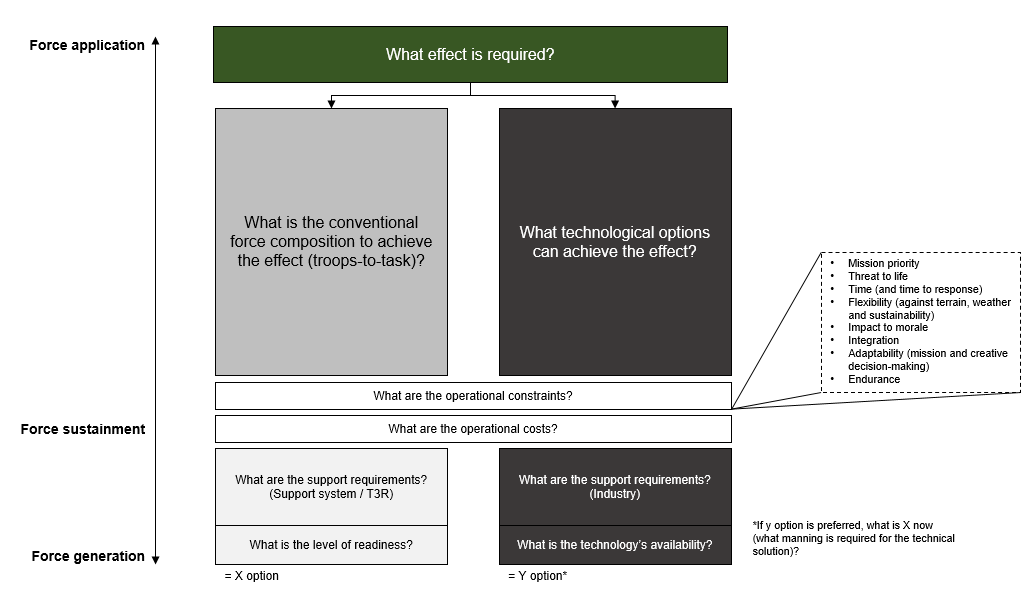A decision support model to evaluate force composition
Introduction
The Australian Defence Force (ADF) is approaching a strategic environment that is less benign, more demanding and of higher risk to life and safety. Compounding these strategic risks are worsening resourcing (workforce and funding) challenges – a characteristic not uncommon across previous periods of relative peace in Australia. Critical to issues of concurrency, particularly for Army, is the inescapable truth that operational activities often take place where humans live and reside – on the land.[1] These factors raise a daunting and essential question for the Army of this future: ‘how do you achieve more with less, possibly when your forces are already committed?’ In this contribution to the Land Power Forum (LPF), I propose a model to enable assessment of conventional force options and autonomous solutions. In doing so, my aim is to provide a decision support tool for senior leaders when considering solutions to this unfortunately very real question of force application. Publishing this model on the LPF is intended to encourage debate; it is only through the sum of our collective knowledge that we can achieve more innovative thinking.
Concurrency demands and grounding analysis in effect
It is a well-accepted notion that Australia has faced increasing concurrent demands across the spectrum of conflict from national emergencies to stability operations and larger scale combat operations. Recently, however, following the release of the Defence Strategic Review 2023 Australia has reintroduced ‘the highest level of strategic risk’ into the consideration of concurrency demands.[2] Specifically, Australia is facing ‘the prospect of major conflict in the region that directly threatens our national interest’.[3] Importantly, within this expanse of possible concurrent operations, the DSR recommends Defence be ‘the force of last resort for domestic aid to the civil community’ (DACC) – a role it has increasingly been tasked to fulfil.[4] Despite the strategic intent to reduce the DACC liability, however, Australia is likely to remain reliant on the ADF for these tasks unless there are significant (to the sum of changes in gross domestic product) resourcing and structural changes of other services capable of managing national emergencies. To solve for uncertainty created by the range of possible scenarios, the Australian Government directed the commencement of accelerated preparedness – the enhancement of warfighting capability and self-reliance in national defence.[5] The remainder of the solution, however, lies in the realisation of accelerated preparedness – the ways in which Groups and Services, through the Integrated Force, remediate capability and infrastructure shortfalls as well as capitalise on strengths of current capability. For Army, capability is grounded in people. Part of Army’s capacity to deliver accelerated preparedness therefore lies in optimising, or reducing the burden on, its people to achieve strategic effects.
Technology is playing a vital role in helping humans work more productively, or in reduced numbers. In theory then, autonomous solutions can either enhance a conventional force effect (as a force multiplier) or reduce the number of conventional capabilities required to achieve the same effect. The critical component of consideration here is the effect – it is the dependent variable, the outcome. As such, to assess whether a human, machine or combined approach to the military task is required, it is necessary to evaluate both the conventional force composition and technological (autonomous) solutions that could achieve the desired outcome.
Assessing force compositions
Traditionally, there are a range of methods to assess the workforce requirement to achieve a strategic effect or mission. Three of the leading methodologies include the ‘correlation of forces model’ (estimate combat power ratio between opposing forces), ‘relative combat power analysis’ (compare combat power based on enemy strengths against friendly weaknesses) and ‘troops-to-task’ (allocation of resources to accomplish specified and implied tasks).[6] Integrating several of these methodologies provides the most robust estimate of a future land force as no single approach accounts for the impact of integration at the joint/national level, multiple domains or the blending of operations across the spectrum of conflict. Of note, the ‘troops-to-task’ methodology generates the most reliable outputs for assessing workforce operational demand because it considers factors identified by the other analytical approaches (such as adversary capability). In its simplest form, troops-to-task entails the identification of the force density required for mission success. This methodology also provides key results related to the unit size and type required for specific missions and effects. Similar considerations are required for analysing possible technical solutions – however, the analysis is closer to a ‘specifications-to-task’ analysis where a platform’s ability constrains what it can do.
Assessing costs and operational constraints
Evaluating options in force employment often comes down to an assessment of cost and operational risk. When considering the force composition of conventional and non-conventional options, it is necessary to evaluate what is feasible based on the absolute minimum force required and its cost. Assessing the cost of conventional options involves reliance on subject-matter expertise and is a relatively straightforward process as those experts are generally available within the ADF. It is also simple to model the cost of conventional forces based on historic and current data. However, evaluating the cost of technical solutions requires industry input, market analysis and modelling for development and production at scale.
Assessing operational risk is always challenging, regardless of whether the options under review are conventional or non-conventional. Operational risk is less quantifiable than cost analyses because it depends on a qualitative assessment of factors related to specific operations. Placing boundaries around this analysis is particularly difficult. As such, this LPF post recommends that assessors consider both opportunities and constraints as they relate to: mission priority, threat to life, time (and time to response); flexibility (against terrain, weather and sustainability); impact to morale; integration; adaptability (mission and creative decision-making); and endurance.[7] For example, an autonomous solution for coastal surveillance provides opportunities to enhance endurance, but may not be capable of responding (rapidly or at all) to an incident if it assesses that such a response would risk the overall mission success. Similarly, a high priority mission (such as preparatory fires in support of amphibious landings) may necessitate a conventional (manned) solution, but increase the threat to life beyond tolerable risk thresholds.
Assessing sustainability
While the factors addressed above enable a 1:1 assessment of capability for an isolated military task, they flounder at scale because they do not consider sustainability. An effective assessment model needs to consider the whole ecosystem required to support concurrent, enduring and/or large-scale combat operation. As such, analysing both the troops-to-task and tooth-to-tail ratio (T3R) are required. The T3R provides a holistic workforce estimate by determining the level of support (tail) required to sustain combat (tooth) functions. In a conventional workforce assessment, this is a simple estimate of the number of people required to support those deployed in combat roles – during the peak of Australia’s commitment to Afghanistan this was 1:14 (where it took 14 support personnel to maintain one individual in the field). However, assessing the T3R for technical solutions is significantly more complex and relies heavily on inputs from industry that are not only related to people, but to the supply of materials and a civilian workforce that may be employed elsewhere within the National Support Base. The generation of such an assessment system is an evolving field of analysis. Collaboration between Defence and industry will elucidate some of these variables and enable further analysis to determine which factors are correlated most significantly to the support of autonomous systems.
Assessing force generation
As the penultimate factor considered within this model, the delivery of a solution at the point of need will ultimately determine whether the effect is, or could be, achieved. In this way, preparedness is closely linked to sustainment as the effect may be enduring. For a conventional workforce, this is assessed based on levels of readiness and training throughput.[8] For technical options, however, force generation is dependent on availability (including reliability of supply chains) or producibility[9] of the technology. Such analysis similarly requires increased engagement and inputs from industry to understand capacity constraints.
The final loop in assessing autonomous solutions
As militaries increasingly understand the potential inherent in autonomous solutions, it is feasible that – in a resource-constrained, high-risk environment – decision makers will opt for low-cost, low penalty options such as autonomous technologies, whenever possible. However, reliance on technology does not diminish the role of humans. As Galbreath, Neads and Farrell observed, capitalising on military opportunities provided by autonomous solutions is reliant upon ‘effective integration of soldiers and autonomous systems, known as human-machine teaming’.[10] If an assessor decides a non-conventional option is a more appropriate or feasible option to meet an operational requirement, then they must reassess in parallel the minimum (essential) human workforce required to employ it.
Conclusion
Increasing concurrent demands within a resource-constrained environment are driving the ADF to consider autonomous solutions in force design. To do so requires an evaluation of the desired effect, capability required, cost, operational risk, sustainment and generation. Analysis of these factors will best position senior leaders to evaluate opportunities presented by autonomous solutions in force composition, enabling the Integrated Force to be deployed in more ways, more places, more often.
This article is a submission to the Spring Series 2023 Short Writing Competition, 'Army’s approach to accelerated preparedness'.
[1] Palazzo, A., Land Warfare, an Introduction, Australian Army Occasional Paper No. 14
[2] Commonwealth of Australia, Department of Defence, Defence Strategic Review 2023, 2023
[3] Ibid
[4] Ibid, p. 41
[5] Ibid, p. 81
[6] Christian, J. T., An Examination of Force Ratios, 2019, School of Advanced Military Studies US Army Command and General Staff College
[7] This list of factors was compiled from NATO Standard APP-28 Tactical Planning for Land Forces – Edition A, Version 1, 2019
[8] Commonwealth of Australia, Australian National Audit Office, Defence Force Preparedness Management Systems, 2004
[9] Ehlers, T., Lachmayer, R., Vajna, S., and Halle, T., ‘Producibility’, Integrated Design Engineering, 2020, Springer, Switzerland, pp. 287-323
[10] Neads, A., Galbreath, D. J., and Farrell, T., From Tools to Teammates: Human-Machine Teaming and the Future of Command and Control in the Australian Army, Australian Army Occasional Paper No. 7, 2021, accessed 25 Oct 23





